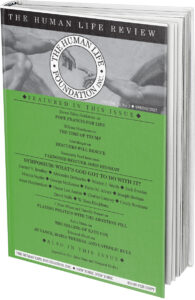Little Girls in Older Bodies
At the altar rail to receive Communion, she knelt, with intention that might not have been so obvious a decade or two ago. Looking up at me, she held out her hands, and then wiggled her fingers to show off her sparkly new manicure. She was a grandmother, but in that moment of pure, sweet joy, she was just like a little girl. She knew I shared her delight in sparkly fingernails, and she had just had hers done for a family wedding. Bringing her joy in that celebration to the altar, in the form of a glittery manicure, she gave me a glimpse of her emotional state—her sense of who she truly was—and a pastoral opening to chat with her during coffee hour.
Without intending to, she had reminded me of another little girl, a genuinely little girl, about four years old, whose sparkles were on her shoes. My mother overheard her as she walked up to our assisting priest and asked, “Do you like my shoes, Jesus?” She had noticed his resemblance to pictures she’d seen of Jesus; a common child’s mistake, underscored by her response to the approach of the rector, whom she knew in her childish understanding to be Jesus’ boss: “Do you like my shoes, God?” This little girl, in the same innocent way, turned her sparkles and her trust into a pastoral opening.
Both “girls,” one young, one old, had let their culturally trained guard drop in favor of a momentary delight, and in doing so showed their trust in those who were there to care for them. Young children drop their guard more easily, not yet having experienced the obstacles our culture puts in the way of expressing innocent joy and hopeful trust. Older women may struggle tremendously in this area, but share a desire to be known and loved.
In a senior community Bible study group several years ago, we addressed this struggle head-on in our encounter with Romans 12:1: “present your bodies as a living sacrifice, holy and acceptable to God, which is your spiritual worship.” (ESV) We had all heard this passage before—it comes up often in the life of the Church—but in this setting, the words landed differently. Suddenly, there were uncomfortable laughs, as people who daily perceived their bodies in terms of what they could no longer do, and what they no longer looked like, began to internalize the idea of their bodies being holy, good, even beautiful. There was a sense in the room that nobody had heard this before. Nobody had thought of heaven as physical, worship as intentional, sacraments as material, and their very bodies as worthy and acceptable. The question that hung in the air sounded like “Really? My body, with its aches and pains, how could my body be good and beautiful?”
Modern standards of beauty, we discovered, are lies our culture tells us. In Genesis, God did not ask our opinion when he declared all creation good. He did not ask Adam and Eve, “What do you think?” Nor did he put an expiration date on beauty and worthiness. Eve did not get to ask to be thinner. Adam did not get to ask for a wife with rounder hips. Nor did Adam get to flex in the mirror for a while before declaring his consent to the layout of his muscles and bones. Instead, it was all simply declared good—no discussion.
We worry a lot these days about body image and public opinion, about sexiness and sexuality, but our approach may be fundamentally wrong. For the Christian, the body is good; God made us to bear his image. Jesus took on our physical nature and bore our image, scars and all, into paradise. We are merely stewards over this treasure. Your body is good, noble, and beautiful; you are a hand-crafted icon of God.
I first started using this affirmation, “You are a beautiful, hand-crafted icon of God,” when doing ministry with teenagers. Everyone seems to understand that young women need these affirmations, and I hope I will never forget the expression of relief and gratitude this phrase elicits in youth groups and high school classrooms when I am privileged to repeat it. But our older folks need to hear this too. Their fading physical self was created good, and they can never undo that. It may wear out, even before its time, but physical existence is good—even when we think it the wrong shape, size, or color to meet our exacting standards.
Perhaps as we better understand the blessing of our physical existence, no matter how suffering or broken, we can learn to drop our own guard sometimes and once again be a little girl with sparkles, or an older girl with sparkles, too.










